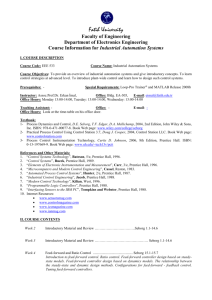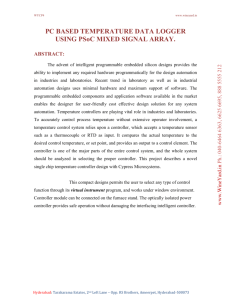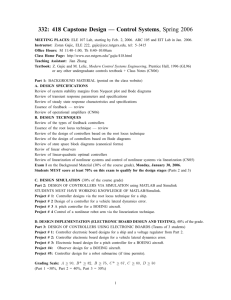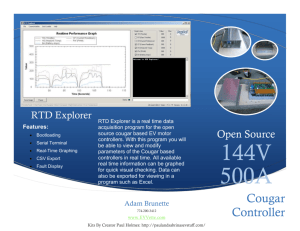Course Information
advertisement
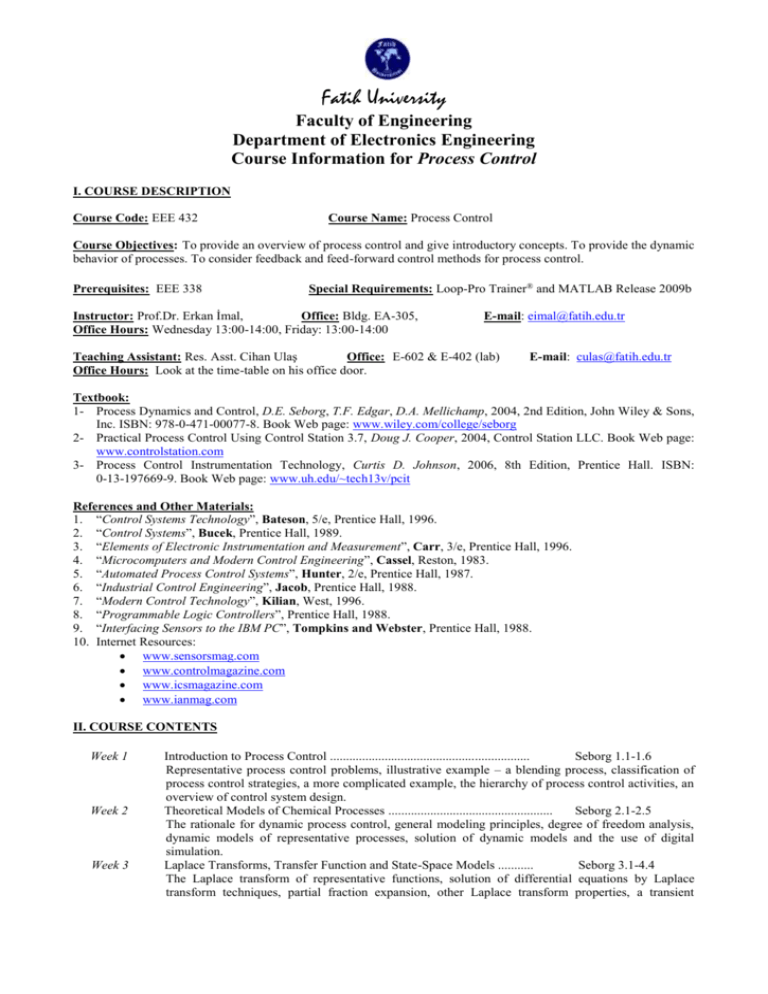
Fatih University Faculty of Engineering Department of Electronics Engineering Course Information for Process Control I. COURSE DESCRIPTION Course Code: EEE 432 Course Name: Process Control Course Objectives: To provide an overview of process control and give introductory concepts. To provide the dynamic behavior of processes. To consider feedback and feed-forward control methods for process control. Prerequisites: EEE 338 Special Requirements: Loop-Pro Trainer® and MATLAB Release 2009b Instructor: Prof.Dr. Erkan İmal, Office: Bldg. EA-305, Office Hours: Wednesday 13:00-14:00, Friday: 13:00-14:00 E-mail: eimal@fatih.edu.tr Teaching Assistant: Res. Asst. Cihan Ulaş Office: E-602 & E-402 (lab) Office Hours: Look at the time-table on his office door. E-mail: culas@fatih.edu.tr Textbook: 1- Process Dynamics and Control, D.E. Seborg, T.F. Edgar, D.A. Mellichamp, 2004, 2nd Edition, John Wiley & Sons, Inc. ISBN: 978-0-471-00077-8. Book Web page: www.wiley.com/college/seborg 2- Practical Process Control Using Control Station 3.7, Doug J. Cooper, 2004, Control Station LLC. Book Web page: www.controlstation.com 3- Process Control Instrumentation Technology, Curtis D. Johnson, 2006, 8th Edition, Prentice Hall. ISBN: 0-13-197669-9. Book Web page: www.uh.edu/~tech13v/pcit References and Other Materials: 1. “Control Systems Technology”, Bateson, 5/e, Prentice Hall, 1996. 2. “Control Systems”, Bucek, Prentice Hall, 1989. 3. “Elements of Electronic Instrumentation and Measurement”, Carr, 3/e, Prentice Hall, 1996. 4. “Microcomputers and Modern Control Engineering”, Cassel, Reston, 1983. 5. “Automated Process Control Systems”, Hunter, 2/e, Prentice Hall, 1987. 6. “Industrial Control Engineering”, Jacob, Prentice Hall, 1988. 7. “Modern Control Technology”, Kilian, West, 1996. 8. “Programmable Logic Controllers”, Prentice Hall, 1988. 9. “Interfacing Sensors to the IBM PC”, Tompkins and Webster, Prentice Hall, 1988. 10. Internet Resources: www.sensorsmag.com www.controlmagazine.com www.icsmagazine.com www.ianmag.com II. COURSE CONTENTS Week 1 Week 2 Week 3 Introduction to Process Control .............................................................. Seborg 1.1-1.6 Representative process control problems, illustrative example – a blending process, classification of process control strategies, a more complicated example, the hierarchy of process control activities, an overview of control system design. Theoretical Models of Chemical Processes ................................................... Seborg 2.1-2.5 The rationale for dynamic process control, general modeling principles, degree of freedom analysis, dynamic models of representative processes, solution of dynamic models and the use of digital simulation. Laplace Transforms, Transfer Function and State-Space Models ........... Seborg 3.1-4.4 The Laplace transform of representative functions, solution of differential equations by Laplace transform techniques, partial fraction expansion, other Laplace transform properties, a transient Week 4 5.4 Week 5 Week 6 7.5 Week 7 Week 8 9.4 Week 9 Week 9 Week 10 Week 10 11.5 Week 11 Week 12 13.5 Week 13 Week 14 15.7 Week 15 response example, development of transfer functions, properties of transfer functions, linearization of nonlinear models, state-space and transfer function matrix models. Dynamic Behavior of First-Order and Second-Order Processes ............................ Seborg 5.1Standard process inputs, response of first-order processes, response of integrating processes, response of second-order processes. Dynamic Response Characteristics of More Complicated Processes ...... Seborg 6.1-6.5 Poles and zeros and their effect on process response, processes with time delay, approximation of higher-order transfer functions, interacting and noninteracting processes, multiple-input, multipleoutput (MIMO) processes. Development of Empirical Models from Process Data.......................................... Seborg 7.1Model development using linear or nonlinear regression, fitting first- and second-order models using step tests, neural network models, development of discrete-time dynamic models, identifying discrete models from experimental data. Feedback Controllers ............................................................................... Seborg 8.1-8.6 Introduction, basic control modes, features of PID controllers, on-off controllers, typical responses of feedback control systems, digital versions of PID controllers. Control System Instrumentation ............................................................................ Seborg 9.1Transducers and transmitters, final control elements, transmission lines, accuracy in instrumentation. M i d t e r m E x a m (23 November 2009, Monday) Overview of Control System Design ....................................................... Seborg 10.1-10.5 Introduction, the influence of process design on process control, degrees of freedom for process control, selection of controlled, manipulated, and measured variables, process safety and process control. O f f i c i a l H o l i d a y (30 November 2009, Monday - The Muslim Festival of Sacrifice) Dynamic Behavior and Stability of Closed-Loop Control Systems ....................... Seborg 11.1Block diagram representation, closed-loop transfer function, closed-loop responses of simple control systems, stability of closed-loop control systems, root locus diagrams. PID Controller Design, Tuning, and Troubleshooting ............................ Seborg 12.1-12.7 Performance criteria for closed-loop systems, model-based design methods, controller tuning relations, controllers with two degrees of freedom, on-line controller tuning, guidelines for common control loops, troubleshooting control loops. Frequency Response Analysis ................................................................................ Seborg 13.1Sinusoidal forcing of a first-order process, sinusoidal forcing of an nth-order process, Bode diagrams, frequency response characteristics of feedback controllers, Nyquist diagrams. Control System Design Based on Frequency Response Analysis ……… Seborg 14.1-14.6 Closed-loop behavior, Bode stability criterion, Nyquist stability criterion, gain and phase margins, closed-loop frequency response and sensitivity functions, robustness analysis. Feed-forward and Ratio Control ………………………………………….……… Seborg 15.1Introduction to feed-forward control, ratio control, feed-forward controller design based on steadystate models, feed-forward controller design based on dynamic models, the relationship between the steady-state and dynamic design methods, configuration for feed-forward-feedback control, tuning feed-forward controllers. Review ..................................................................................................... Seborg 13.1-13.5 III. LABORATORY EXPERIMENTS, TUTORIALS, AND OTHER ACTIVITIES Hands-on workshop series using the LOOP-PRO Version 5 software package for process control analysis, tuning and training will be performed as planned in the following. Week 1 Week 2 Introduction to the control station software package ........................................... Cooper - Chapters 0-0 Exploring Dynamics of the Gravity Drained Tanks ……………..….. Cooper - Chapters 1-3 2 Week 2 Week 3 Week 3 Week 4 Week 4 Week 5 Week 6 Week 7 Week 8 Week 9 Week 10 Week 10 Week 11 Week 12 Week 13 Week 14 Chapter 16 Objective:To generate open loop step test data and learn how to describe the observed dynamic process behavior with a first order plus dead time (FOPDT) model. Also, to learn about the nonlinear nature of processes. P-Only Control of Tank Level …………………………………..…................ Cooper - Chapters 4-5 Objective:To design and test a P-Only controller for tracking changes in set point and rejecting disturbances. Also, to explore how controller gain impacts P-Only performance. The Hazard of Tuning PI Controllers by Trial and Error …………….. Cooper - Chapters 6-9 Objective:To build intuition about PI controller performance and tuning when the control objective is disturbance rejection. Also, to experience the drawbacks of trial and error tuning. PI Control of Heat Exchanger Temperature ……………………………….… Cooper - Chapters 6-9 Objective:To learn about the performance of a PI controller and to explore the interaction of the two tuning parameters on controller performance. Also, to learn how Design Tools can automate the dynamic modeling and controller design task. PI Control of Distillation Top Composition ………………………….. Cooper - Chapters 6-9 Objective:To learn about the PI controller and to explore the interaction of the two tuning parameters on controller performance when disturbance rejection is the control objective. Also, to learn how Design Tools can automate dynamic modeling and controller design. PID Control of Heat Exchanger Temperature ……………………………….... Cooper - Chapter 10 Objective:To learn about the tuning and performance capabilities of a PID controller and to explore the interaction of the three tuning parameters on controller performance. O f f i c i a l H o l i d a y (29 th October 2009, Thursday, Republic Festival of Turkey) PID with Filter and Control of the Multi-Tank Process ……………...... Cooper - Chapter 10 Objective:To learn about the tuning and performance capabilities of a PID controller with derivative filter when measurement noise is large, and to explore the interaction of the four tuning parameters on controller performance. Adaptive PI Control of Nonlinear Processes ………..………..………..…… Cooper - Chapters 6-10 Objective:To explore how a parameter scheduled adaptive controller can improve controller performance over a range of nonlinear operation. Modeling and Simulation of Single Loop Processes ………………...… Cooper - Chapters 6-7 Objective:To learn how Design Tools and Custom Process can be used to model, simulate and explore controller design of single loop processes. Cascade Control of the Jacketed Reactor …………………………….………. Cooper - Chapter 11 Objective:To explore cascade controller design and implementation. Also, to compare disturbance rejection performance of a cascade architecture with that of a lone PI controller for the jacketed reactor process. Feed Forward Control of the Jacketed Reactor ……………………....…. Cooper - Chapter 12 Objective:To explore feed forward controller design and implementation. Also, to compare disturbance rejection performance of a feed forward controller with that of a lone PI controller for the jacketed reactor process. Advanced Feed Forward Control of the Heat Exchanger ………………….... Cooper – Chapter 12 Objective:To explore advanced modeling issues and the impact of plant-model mismatch on feed forward controller performance. Multivariable Decouplers and Distillation Control ……………………..… Cooper - Chapters 13-14 Objective: To observe control loop interaction on a multi-loop process and to design and explore model-based decouplers that minimize such interaction. Modeling and Decoupling of Multi-Loop Processes ………………………... Cooper - Chapters 13-14 Objective: To explore multivariable modeling issues and to learn how Design Tools and Custom Process can be used to model, simulate and explore multi loop processes. Dead Time Compensation Using the Smith Predictor ……………..…..... Cooper – Chapter 15 Objective: To design, implement and explore the capabilities of the model-based Smith predictor on processes with significant dead time. Dynamic Matrix Control (DMC) of the Gravity Drained Tanks ………………. Cooper Objective:To explore DMC design and implementation. Also, to explore how the tuning parameters impact DMC performance. Week 15 L a b o r a t o r y F i n a l E x a m (07 January 2010) 3 IV. EXAM DATES, GRADING POLICY AND ATTENDANCE Exam Dates Midterm Exam : 23 November 2009, Monday (week 9) Lab Final Exam : 07 January 2010, Thursday (week 15) Final Exams : January 11-24, Monday - Sunday, 2010 Grading Policy Homework: 10 %, Quiz: 15%, Laboratory: 20%, Midterm Exam: 25 %, Final Exam: 30 % Attendance (Clause 17 of the Undergraduate Regulation) Classroom attendance is mandatory. Students, who are absent over 30% of the class time and 20% of the lab time, automatically fail the course. Repeating students are exempt from attendance for a theoretical course only if the attendance is fulfilled at least once for that course before. Honor Code: All work done on the exams will be done on your own and pledged. Students may discuss homework concepts and approaches, but the work will be done by the individual. Group or copied solutions are not permitted. Homework is considered pledged simply by its receipt. Late Work and Examinations: Normally, homework is due one week from the assigned date, unless otherwise indicated or previous arrangements are made. Late homework will be accepted due to sickness only. Students who know that they are going to miss class and/or lab session should make arrangements in advance. A student who has not attended three lab sessions without an excuse, and therefore had his/her lab reports not accepted will be treated as failed in the course. Only selected homework problems may be graded from the set turned in. The others will be checked for completion. Exams will be closed notes, open book and in-class. 4




